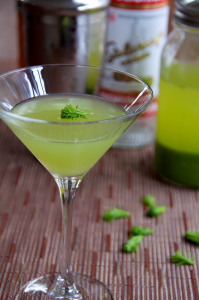 I SEE A THREE-firtini lunch in my future…
I SEE A THREE-firtini lunch in my future…
Believe it or not, the new growth of many conifers, even pine trees, is edible. Certain species of fir and spruce are the most sought after for their tender and fragrant tips.
Simply chopped and sautéed in butter with mushrooms or potatoes, fir and spruce tips bring the forest right into your kitchen, with wafting evergreen aromas and the evocation of cool mountain shade. Infusions are another crowd-pleaser. You can use the pungent tips to infuse stock, cream, or alcohol. At the Herbfarm I’ve enjoyed a champagne cordial infused with a small shot of spruce tip extract.
For this drink, I first turned to The Wild Table for a quick primer on infusing alcohol with Douglas fir tips.
1 cup Douglas fir tips
1 750 ml bottle of vodka
1. In a blender, combine fir tips with 1/3 bottle of vodka and blend for 2 minutes. Pour into a quart-sized jar. Empty remaining vodka into blender, swirling around to capture fir tip residue and add into same jar. Seal jar, shake, and refrigerate for 1 week.
2. Strain fir-infused vodka, first through a fine mesh strainer, then through a strainer lined with folded cheesecloth. Serious mixologists can opt for a third filtration through a coffee filter, which takes a while but yields an ethereal, nearly transparent result. *
3. Keep fir-infused vodka in fridge or freezer.
To make a Firtini, add fir-infused vodka to a shaker with ice and a splash of elderflower syrup. Garnish with a tip.
* The photo at top depicts a firtini that’s only filtered twice.




Hi Langdon
The flavor of this when I made it was great but the color didn’t have your super bright green tint – more pale yellow/green.
I grabbed tips off the trees at Hama Hama oyster farm on Hood Canal a few weeks ago.
Does the variety of the tree influence this probably?
Hi Sean – if you’re using Doug fir tips, the color is most influenced by how you strain and filter. Repeated straining will remove sediment and also color. Many mixologists are looking for that ethereal transparent appearance with just a hint of tint, which requires a coffee filter and plenty of time. Mine in the photo was strained through wire mesh and then cheesecloth as I recall. Remember to only use the newly emerged tips, which will be soft and a lighter, brighter green than the rest of the foliage.